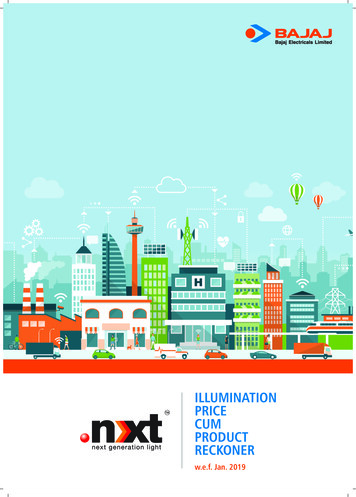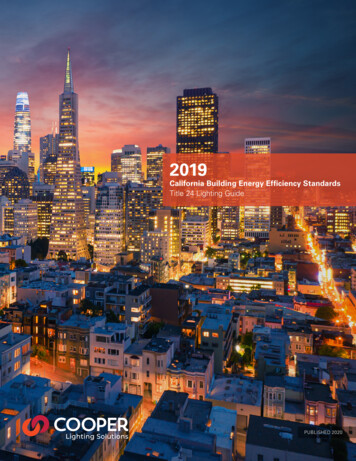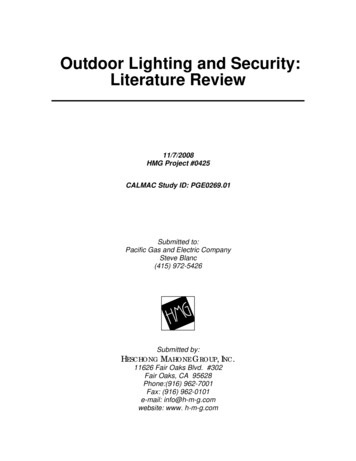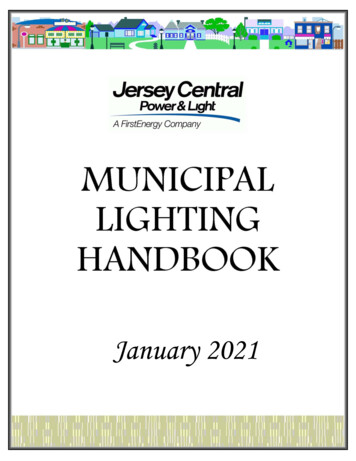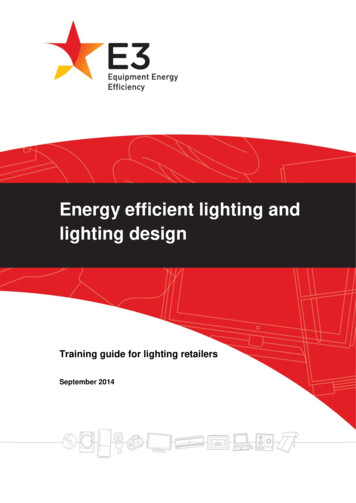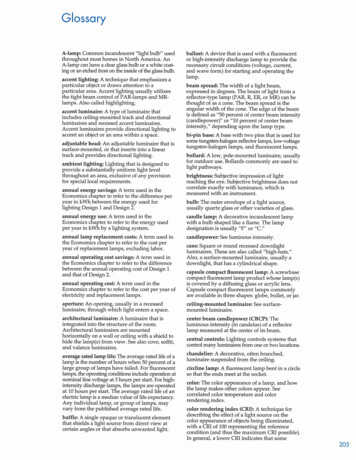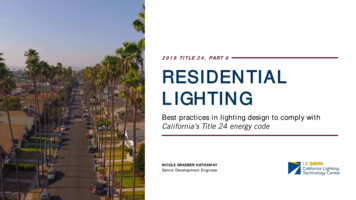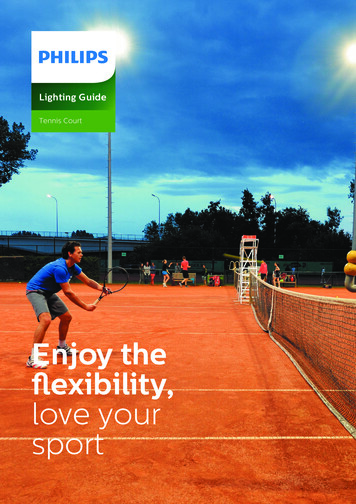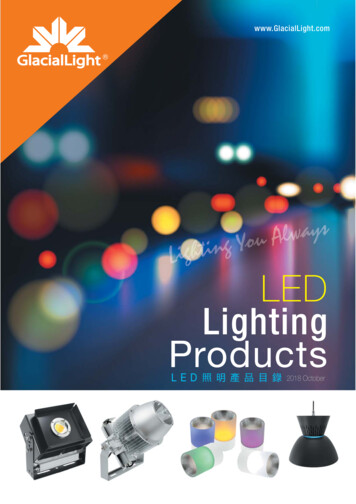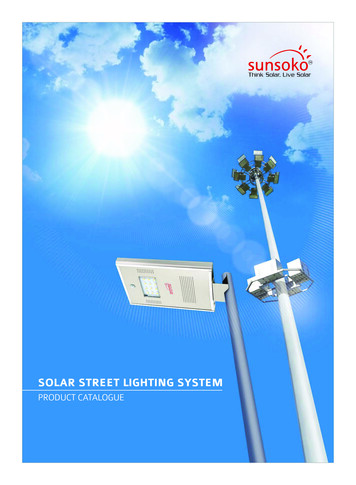
Transcription
MDTA LightingGuidelinesMay 2019Prepared by:
Lighting Design GuidelinesMay 2019TABLE OF CONTENTSPART I – INTRODUCTIONPage 1PART II – CRITERIA FOR ELIGIBILITYPage 2PART III – TYPICAL LIGHTING APPLICATIONSPage 3Section A: Interchange LightingPage 3Section B: Intersection LightingPage 4Section C: Continuous Roadway LightingPage 4Section D: Sign LightingPage 4Section E: Minimizing Lighting System ImpactsPage 6Section F: Light Loss FactorPage 8PART IV – SPECIAL LIGHTING APPLICATIONSPage 10Section A: Bridge LightingPage 10Section B: Rest Area or Park-and-Ride LotsPage 10Section C: Underpass LightingPage 10Section D: Tunnel LightingPage 11Section E: Pedestrian LightingPage 11Section F: Knock Downs and RemovalsPage 11Section G: Temporary LightingPage 11Section H: Campus LightingPage 12Section I: Crossover LightingPage 12APPENDIX
Lighting Design GuidelinesI.May 2019INTRODUCTIONThe Maryland Transportation Authority (MDTA) lighting guidelines follow the MarylandDepartment of Transportation Maryland State Highway Administrations (MDOT SHA) lightingguidelines format but is tailored for facilities owned and operated by MDTA. The purpose of theseguidelines is to provide safe and efficient facilities for the benefit of the public. Safety and impactsof lighting systems are key factors considered in this guide. On a fundamental level, driving islargely a visual task. Being able to adequately see the road/street ahead, signing, obstacles,observe conflicting traffic, and the behavior of other highway users is integral to the driving task.Lighting significantly improves the visibility of the roadway, increases sight distance, and makesroadside obstacles more noticeable to the driver, and therefore more avoidable.Roadway lighting is a proven safety countermeasure. The positive safety effects of lighting havebeen documented in various reports and publications. For example, an FHWA/AASHTOinternational scan documented that many countries showed a 20 to 30 percent reduction in thenumber of crashes when lighting was installed. The FHWA Lighting Handbook also cites otherstudies to show an even greater benefit of lighting with results ranging from a 60-65 percentreduction of fatal crashes, up to a 50 percent reduction in injury crashes, and close to a 20 percentreduction in property-damage-only crashes after roadways are lit.Exterior lighting systems also have an impact on people and the environment. Light at nightcreates skyglow from scattered light in the atmosphere, light trespass can impact abutters, andwildlife can also be impacted by nighttime lighting. The key in limiting these impacts is limitingthe dosage and duration and at times controlling spectral content of the exterior lighting systems.This guide uses the latest research in the areas of lighting, safety, and impacts to balance therecommendations included herein.The proper selection of lighting equipment and the location of street lighting will provide sufficientvisibility, increased safety, and improved security for motorists and pedestrians while maximizingenergy efficiency and minimizing expenditure. Lighting also has adverse effects that includeglare, light trespass and sky glow that should be considered when deciding to install roadwaylighting. The Local Jurisdiction’s commitment to participate in the design, construction, operationand maintenance of the lighting system should also be a consideration.All new lighting (interchange and intersection), underpass and sign lighting shall be designedusing light emitting diode (LED) fixtures. LED fixtures should also be considered for pedestrianlighting. An Engineering study, assessment of site conditions and field testing should becompleted to determine appropriate fixture type for tunnels and high mast lighting. LED roadwayfixtures shall be selected from the MDOT SHA Qualified Products List (QPL).1
Lighting Design GuidelinesMay 2019This guideline is separated into three sections:···II.The Criteria for Eligibility section defines the circumstances which qualify a roadway tobe considered for the installation of lightingThe Typical Lighting Applications section describes the common applications of lightinginstallationsThe Special Lighting Applications section describes the various applications in relationto the roadways in which lighting shall be consideredCRITERIA FOR ELIGIBILITYTo determine the eligibility for lighting installations, MDTA requires an engineering study of localconditions considering such factors as crash data, roadway characteristics and ambient light tosupport lighting installation decisions and to promote motorists’ safety. When there is a history ofcrashes, the type and circumstances of the crashes should also be considered in a study.Engineering judgment should be used in instances where an operational or safety concern is notindicated by the crash data. Traffic volumes can also be used as a supplemental measure inevaluating lighting eligibility. Further, The American Association of State Highway ageview.aspx?id 633&DB 3)outlinesminimumconditions for when to consider lighting shall be used when determining eligibility for all lightinginstallations. Another resource for use in safety studies is the FHWA Roadway Lighting Handbook(https://safety.fhwa.dot.gov/roadway dept/night visib/lighting handbook/)whichdiscussesAASHTO and other warranting methods which may help in the decision process.The conditions for eligibility for specific facility types are described in the following sections.Meeting these conditions does not obligate MDTA to provide lighting nor is it a requirement forinstallation of lighting in special circumstances.2
Lighting Design GuidelinesIII.May 2019TYPICAL LIGHTING APPLICATIONSRoadway lighting may be provided in areas determined to be eligible in Section II and the extentof the lighting shall be as discussed in AASHTO Roadway Lighting Design Guide for PartialInterchange Lighting (PIL), Complete Interchange Lighting (CIL), or Continuous Freeway Lighting(CFL). The decision concerning which extent to use shall consider the warranting conditions aswell as the location, lighting treatment in the surrounding area, and concurrence from MDTA.A. Interchange LightingPartial Interchange Lighting will be installed on all approaches at new and reconstructedgrade-separated interchanges across the state. At existing grade-separated interchangeswithout interchange lighting; lighting will be installed based on an established needincluding nighttime crash history, site-specific conditions and engineering judgement.Secondary ramp merges and diverges will be treated in the same manner as mainlineexits. Figure III-A.1 in the Appendix should be used as a reference for lighting placements.The installation of additional lights is at the discretion of the MDTA. For all lightingplacements, the entering and/or exiting lane(s) and one (1) adjacent mainline travel laneshall be analyzed when determining proper spacing as shown in Figures III-A.2 and IIIA.3 of the Appendix.Refer to Table III-A.4 of the Appendix for recommended lighting values for interchangesWhen proposed lighting designed to meet these guidelines and recommended valuesresults in more than 600 feet between any two light poles, additional lighting may beproposed to decrease pole spacing in that section based on an Engineering Study.Complete interchange lighting shall be considered on facilities with one or more of thefollowing characteristics:1. Ramps, interchange alignments, or grades which are complex or unusual. Thisincludes ramps with substandard deceleration or acceleration lanes, full loops,compound curves, lane reductions and/or multi-lane ramps.2. Important decision point(s) or existing roadside hazard areas that would not becovered with partial interchange lighting, e.g. crossovers.3. An operational analysis indicates the need for lighting. Volume and crash datashould be used to support the analysis.4. Locations with significant pedestrian or bicycle activities during times of darkness.High mast lighting can be considered along MDTA roadways if lighting levels cannot beachieved with low level lighting and is justified by an engineering study.3
Lighting Design GuidelinesMay 2019B. Intersection LightingIntersection lighting should be provided in accordance with the SHA guidelines forintersecting roadways. Other Intersection lighting considerations can include:1. All signalized intersections will have partial intersection lighting.2. All roundabouts will have lighting (refer to Appendix Section III-B.1 for the MDOTSHA Roundabout Guidelines for placement and illuminance requirements.)3. All unsignalized intersections for which a need is determined based on the MDOTSHA Evaluation Form for Intersection Lighting. Refer to Table III-B.2 of theAppendix for the Maryland State Highway Administration Evaluation Form forIntersection LightingLighting should be located on the downstream side of an intersection and coverage mayinclude channelized (free) right turn lanes. See Figure III-A.1 of the Appendix for examplelighting configurations. Where possible, the placement of the luminaire on a signal poleis preferred at signalized intersections. The conduit system for intersection lighting shallbe dedicated for lighting only and shall not be shared with the signal cable unless theluminaire is mounted on the signal pole or otherwise directed by the MDTA. Further,service pedestals may be shared for lighting and signals at the discretion of the MDTA.Refer to Table III-B.3 of the Appendix for recommended lighting values for intersectionsother than roundabouts. Additional consideration should be given to intersections wherecontinuous lighting is present; refer to IES RP-8 Standard Practice for Roadway Lightingfor more information.C. Continuous Roadway LightingContinuous roadway lighting will only be installed when justified by an engineering studyand approved by the MDTA. If approved, it will be installed using the illuminancerequirements included in Table III-A.4 or the luminance requirements in Table III-A.5.D. Sign LightingTraffic signs are placed along the roadway in strategic locations and are used to conveyspecific, consistent messages to motorists. The standards used in the design of trafficsigns are described in the Maryland Manual on Uniform Traffic Control /2011 rev122011 MDMUTCD Complete.pdf.The intent of these standards is to ensure that all traffic signs are designed and maintainedto provide information that can quickly and accurately convey the necessary informationand to provide national sign design consistency. The MDMUTCD states “signs shall beretroreflective or illuminated to show the same shape and similar color by both day andnight”.4
Lighting Design GuidelinesMay 2019Nighttime sign legibility can be achieved in one of two ways:1. Using Type XI retroreflective sheeting materials for the legend and background.2. Using either internal or external sign illumination.Almost all signs are made with retroreflective sheeting materials. Only some signs areilluminated, and generally those are overhead guide signs and overhead street namesigns. The added sign illumination helps compensate when the vehicle headlamps andretroreflective properties of the sign sheeting materials are inadequate by themselves.A sign designed to be legible under daylight conditions can be illuminated to fulfill its basicpurpose at night. A properly designed sign lighting system can aid motorists with the rapidand accurate recognition of the sign’s shape, color, and message. This serves to improvesafety by reducing the possibility that motorists will significantly reduce their speed atlocations where signs may be otherwise difficult to read.Overhead signs shall be installed with ASTM Type XI sheeting and shall not require signlighting. When Type XI retroreflective sheeting is used on signs they generally do notrequire supplemental lighting. However, overhead sign lighting should be consideredunder the following conditions:1. Signs in areas having a high level of visual complexity. This includes areas liketoll facilities (e.g. toll rate sign).2. All overhead signs with unencumbered sight distance of less than 1,000 feet.Unencumbered sight distance exists if all portions of every overhead sign panelon that structure is visible to motorists in all approaching lanes.i. Signs beyond sag vertical curves and outside the influence area ofvehicle headlamps.ii. Signs in horizontal curves that are outside the influence area of vehicleheadlamps.3. Signs in areas where atmospheric conditions create condensation or frost on thesign face and reduce the effectiveness of the retroreflective sheeting. Thisincludes areas adjacent to bridge structures and other areas prone to fogconditions.4. Additional lighting may be considered and requested as part of an engineeringstudy and/or based on engineering judgement to address site specific conditions.Sight distance, as noted above, should be considered when selecting locations for newstructures.When sign lighting is provided:1. Lighting shall consist of LED luminaires.2. Individual supports for each luminaire is the preferred mounting method; signlighting maintenance systems should only be used at the discretion of MDTA.3. All overhead sign panels mounted on a structure shall be illuminated. Lightingonly select panels is not permitted even if signs have different ownership.5
Lighting Design GuidelinesMay 2019All new signage requires Type XI sheeting so the need for sign lighting will be determinedper the above criteria. If any overhead sign does not require sign lighting it shall use TypeXI sheeting which shall be specified on the sign detail sheets. Refer to the DesignGuidance for Incorporating New Sign Lighting Guidelines in the Appendix for additionalinformation regarding the installation, replacement, removal and design of sign lighting.E. Minimizing Lighting System ImpactsWhen installing lighting on any MDTA facility the impacts of the lighting system should beconsidered specifically addressing the areas of sky glow, light trespass, and any potentiallighting and health impact.In general, the following key actions should be performed as part of the design:1. Perform a review or walk-through of the site during the pre-design stage. Thisshould include an analysis of adjacent property and nearby developments as wellas an investigation into the community desires for lighting systems.2. Select a luminaire whose candela distribution pattern matches the need. Establishthe position of the luminaire precisely. If calculations then show the light distributionwill be objectionable, make modifications to wattage or mounting height, or selectanother luminaire.3. Consider internal and external shields if necessary to limit the candela in certaindirections. Also, consider that internal and external shields will alter thephotometric distribution of the fixture and account for such alterations in the lightingsystem design.4. Consider pole location, mounting height, spacing, finished terrain, and landscapingas design variables that can be used to mitigate light trespass. Take advantage ofnatural and man-made obstacles such as tree lines and retaining walls.5. Remember that glare or visual clutter can be produced by almost any luminairewhen observed against a dark background. Choose luminaires and placementswith care.Minimizing SkyglowThe Illuminating Engineering Society (IES) developed a recent simplified method ofclassifying luminaires beyond the traditional roadway classifications of full cutoff, cutoff,semi-cutoff and non-cutoff. This system was published in the IES Technical Manual, TM15 Luminaire Classification System for Outdoor Luminaires. This system considers theamount of light emitted by a luminaire and places a light zone value for Backlight, Uplightand Glare. The system (shortened to BUG) was developed alongside the Model LightingOrdinance (MLO). The MLO defined lighting requirements and restrictions and createdlighting zones according to environmental impact. The following lighting zones have beenestablished:1. LZ0: No ambient lighting – Areas where the natural environment will be seriouslyand adversely affected by lighting.6
Lighting Design GuidelinesMay 20192. LZ1: Low ambient lighting – Areas where lighting might adversely affect flora andfauna or disturb the character of the area.3. LZ2: Moderate ambient lighting – Areas of human activity where the vision ofhuman residents and users is adapted to moderate light levels. Lighting maytypically be used for safety, security and/or convenience but is not necessarilyuniform or continuous. After curfew, lighting may be extinguished or reduced asactivity levels decline.4. LZ3: Moderately high ambient lighting – Areas of human activity where the visionof human residents and users is adapted to moderately high light levels. Lightingis generally desired for safety, security and/or convenience and is often uniformand/or continuous. After curfew, lighting may be reduced as activity levels decline.5. LZ4: High ambient lighting – Areas of human activity where the vision of humanresidents and users is adapted to high light levels. Lighting is generally considerednecessary for safety, security and/or convenience and is mostly uniform and/orcontinuous. After curfew, lighting may be reduced in some areas as activity levelsdecline.The BUG system allows a simplified method of generally classifying a luminaire withregard to the amount of light emitted from the front, back, and upward. Lower BUG ratingvalues for backlight (B values) and uplight (U values) will generally produce less impactbehind and above the fixture.For control of skyglow, MDTA projects shall only use luminaires with an uplight rating ofU-0 for all environmental zones.Minimizing Light TrespassThere are methods of quantifying light trespass which are used as part of IES RP-8Standard Practice for Roadway Lighting and included in IES RP-33 Lighting for ExteriorEnvironments. This method has also been included in the joint IDA-IES Model LightingOrdinance.The method includes evaluating light trespass of an exterior lighting system in termsmaximum vertical illuminance at any point along a plane at a property line. The limits ofvertical illuminance are based on the LZ zone which the lighting system is located. Themaximum values are included in the table below.Lighting ZoneLZ-0Lighting ZoneLZ-1Lighting ZoneLZ-2Lighting ZoneLZ-3Lighting ZoneLZ-40.05 fc0.1 fc0.3 fc0.8 fc1.5 fc(0.5 lux)(1.0 lux)(3.0 lux)(8.0 lux)(15.0 lux)7
Lighting Design GuidelinesMay 2019Lighting installations for MDTA shall meet the light trespass values shown above. Theselimits are the vertical illuminance value along a property line (or at a residence as agreedto by MDTA) at a height of 5’.In addition to the light trespass limits shown above, there are also cases where fixturebrightness can be cited as an issue from abutters. This more commonly occurs with highmast luminaires and at times can be from properties at quite a distance from theinstallation where no measurable light can be attributed to the roadway lighting system.Generally, this issue is a perceived brightness issue where the bright source beingcontrasted against the dark sky is found objectionable. In most cases, this issue can onlybe addressed with shielding the luminaire optics from direct view from the abutter. Itcannot always be done while maintaining the required lighting levels on the roadway so itneeds to be addressed on an individual basis.Minimizing Health impactsThere has been a significant amount of discussion concerning potential health impacts oflight at night and some of this discussion has included the use of LED streetlights. Thereis also much disagreement between national groups including the American MedicalAssociation, the Illuminating Engineering Society, the US Department of Energy, andmany researchers on various aspects of the topic. Based on these discussions and thecurrent available research the following key points emerge:1. Light at night has potential health risks based on several factors including dosage(amount of light), duration (exposure time), and spectral content (color content).2. Streetlighting, particularly when using the light trespass limits prescribed above,does not appear to provide sufficient dosage to be a health impact.3. Spectral content of light sources has impacts to health and visibility. For example,if the dosage is high enough, sources with a higher blue spectral content havegreater impacts (on circadian disruption) than sources with less blue content.From a visibility perspective, when comparing 4000 0K sources (more blue) and30000K sources (less blue), detection distances appear significantly greater withthe 40000K sources in some early studies.Current studies however show that properly designed roadway lighting will not have animpact on health and that 40000K CCT sources appear to offer longer detection distancesthan other currently offered CCT LEDs. Considering these key points the Correlated ColorTemperature (CCT) for MDTA exterior lighting projects shall be 4000 0K. 30000K sourcescan be considered but may require a slightly higher design value to compensate forreduction in detection distances.F. Light Loss FactorThe construction of Solid State Luminaires (SSL) can be quite different than High-IntensityDischarge (HID) luminaires. Some optical systems use individual LEDs with individualrefractors, others use external lenses, and others use reflector systems or light guides as8
Lighting Design GuidelinesMay 2019part of their design. The amount of dirt depreciation for different types of designs will varysignificantly.The IES produced the document (Illuminating Engineering Society, 2016) RES-1-16Measure and Report Luminaire Dirt Depreciation (LDD) in LED Luminaires for Street andRoadway Lighting Applications. This document is based on research conducted by VTTImeasuring the dirt depreciation of various optical systems and the effect of cleaning onthose luminaires. The results of this research offer advice on predicting dirt depreciationfor different optical systems. The results of the research compared the light output fromthe luminaire for installation, after 2 years (Dirty) and then cleaned after 2 years (Figure8). These results then allowed for the calculation of the light loss due to lumen depreciationand due to dirt depreciation (Figure 9). In this calculation, the results from different opticalmethods (Glass and reflector and individual optics) can be compared.Other factors also require consideration when determining the Light Loss Factor (LLF) ofSSLs. LEDs are very temperature dependent in terms of output and estimated life. ManyLED luminaires also have an automatic output adjustment if internal fixture temperaturesget too high. Failure of an LED luminaire often occurs at the LED driver which has anestimated failure rate determined by Mean Time Between Failure (MTBF) calculations.The rated life of an LED luminaire is based on the point in time when the lumen output ofthe LED has reduced to 70% of its initial lumen rating. Some of these factors are quantifiedand included in the LED test data performed in accordance with (Illuminating EngineeringSociety, 2011) Projecting Long Term Lumen Maintenance of LED Light Sources. Otherdata is usually available from the luminaire manufacturers.The LLF used for design on an MDTA project will include a calculation of the light lossusing actual luminaire data and agreement by MDTA.Reference DocumentsIES RES-1-16 Measure and Report Luminaire Dirt Depreciation in LED Luminaires forStreet and Roadway Lighting Application -ansi-standards/roadwaylighting/)IES LM-79 Approved Method for the Electrical and Photometric Measurements of nts-of-solid-state-lighting-products/)IES LM-80 Approved Standard for Measuring Lumen Maintenance of LED Light f-led-packages-arrays-and-modules/)9
Lighting Design GuidelinesIV.May 2019SPECIAL LIGHTING APPLICATIONSA. Bridge LightingBridge lighting will be evaluated using the Roadway Lighting criteria provided above,particularly the approach transition areas, with the following exceptions:1. Existing bridge lighting which will not be impacted by a roadway project mayremain in place.2. Pedestrian Lighting on bridges will be installed in accordance with the MDOTSHA’s Pedestrian Lighting Policy.3. Decorative lighting should not be installed on bridges without sidewalks. When asidewalk is present, the installation of lighting should be in accordance to theMDOT SHA’s Pedestrian Lighting Policy.4. Areas where surveillance (CCTV cameras), security, identification of disabledvehicles or environmental conditions such as industrial waste or fog may be aconcern.5. If aesthetic lighting is desired by MDTA on a bridge structure the lighting levels onthe bridge should be in accordance with IES RP-33 Lighting for exterior-environments/)6. All other lighting applications shall be determined as per the discretion of theMDTA.B. Rest Area or Park-and-Ride LotsProvide sufficient illumination for public safety purposes at both rest areas, travel plazasand park-and-ride lots. Refer to Table IV-B.1 of the Appendix for recommendedIlluminance Levels for Roadway Rest Areas and Table IV-B.2 of the Appendix forrecommended Illuminance Levels for Parking Areas. Access ramps to and from the facilityshould be treated as interchange ramps and illuminance values as defined in Section IIIA of this document.C. Underpass LightingThe need for underpass lighting shall be based on an Engineering Study. Nighttimeunderpass lighting shall be designed to meet the same requirements as for the approachroadways and if a sidewalk is present, in accordance with Table IV-E.2. If the pedestrianarea is separated from the roadway by a wall or otherwise isolated, then the values shallbe in accordance with Table IV-C.1. Based on the Study, the need for daytime lights shallinclude consideration of ambient light levels.10
Lighting Design GuidelinesMay 2019D. Tunnel LightingTunnel lighting shall be designed in accordance with the IlluminatingEngineering Society RP-22, American National Standard for Tunnel ctices-and-ansi-standards/tunnel-lighting/).The requirements included in RP-22 are generally based on lighting for new longertunnels. The requirements for short tunnels is included in RP-22 but requires engineeringjudgement to their applicability. While re-lighting existing tunnels, crash data is oftenavailable which can help determine if existing light levels are sufficient for safety orwhether changing the levels should be considered. In those existing tunnels, anengineering study can be performed comparing a minimum of 5 years of crash data forthe tunnel threshold/transition zones and approach roads (if valid data is available) todetermine whether current conditions meet the necessary requirements for visibility andsafety at the tunnel entrance.Control systems for tunnel lighting shall also be adequately studied to determine the bestsystem for minimizing energy consumption, maximizing equipment life, and adjusting lightlevels for different zones. For LED tunnel lighting systems, these generally includeadaptive controls dimming the daytime lighting system based on the brightness ofapproach condition to the tunnel portal. The equipment selected must be tested for usein a tunnel environment and have a projected operating life equal to the tunnel lightingsystem.E. Pedestrian LightingThe design and installation of pedestrian lighting is directed by the 2008 MDOT SHA’sPedestrian Lighting Policy (Section IV-E.1 of Appendix). For Recommended Values forHigh, Medium and Low Pedestrian Conflict Areas see Tables IV-E.2, IV-E.3 and IV-E.4 ofthe Appendix. Where pedestrian lighting is installed along a roadway the veilingluminance along the roadway, per Table III-A.4 of the Appendix, shall not be exceeded.F. Knock Downs and RemovalsWhen a light pole is knocked down, maintenance forces should verify with the ElectricalDiscipline Manager if the pole shall be replaced. If replacement of the pole is necessary,the existing fixture shall be upgraded with an LED fixture. If replacement is not necessary,all equipment and the circuits controlling the subject pole need to be verified. Provisionsneed to be made for the maintenance and continued operation of the equipment if otherlighting structures utilize the same circuits. Similarly, if light poles are deemed for plannedremoval, appropriate measures should be taken to ensure continuous operation of otherlighting within the same system.G. Temporary LightingDuring construction, temporary lighting should be provided for decision points. Duringdesign of the project, it should be determined if existing/proposed light poles will11
Lighting Design GuidelinesMay 2019LIST OF APPENDICESSection I-A.1:Light Emitting Diode (LED) Roadway Lighting Specifications and ApprovedLuminaires Memo (December 8, 2012)Figure III-A.1:Examples of Lighting ConfigurationsFigure III-A.2:Analysis Area for Entrance RampsFigure III-A.3:Analysis Area for Exit RampsTable III-A.4:Recommended Lighting Levels for Partial and Complete InterchangeLighting and Isolated IntersectionsTable III-A.5:Recomme
May 16, 2019 · Lighting Design Guidelines May 2019 3 III. TYPICAL LIGHTING APPLICATIONS Roadway lighting may be provided in areas determined to be eligible in Section II and the extent of the lighting shall be as discussed in AASHTO Roadway Lighting Design Guide for Partial Interchange Lighting (PIL), Complete Interchange

